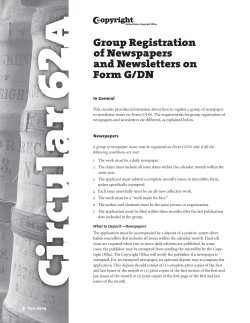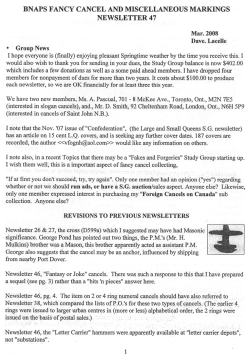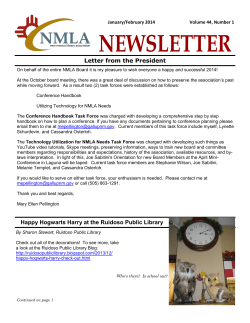
patients over age 50, and this information at the ACEP Emergency Department
From The Editor Welcome to the TSG newsletter. In our prior issue, we followed the failure to diagnose trail from 20,000 feet, and we almost made it to ground level. Getting to the granular analysis is our task in this issue. We will share data that TSG has accumulated and published related to specific elements of clinical behavior and documentation that impact both patient safety and practitioner risk. We share much of this information at the ACEP Emergency Department Directors Academy and other forums, but feel it is relevant to our larger newsletter audience. patients over age 50, and children with fever. That will be enough to fill this issue without getting too lengthy. We will continue this analysis in the next issue. Introduction As you know from our last issue, conditions of the belly, chest and head represent most of our medical errors and malpractice litigation, both in frequency (number of cases) and severity (settlements and judgments). In the graphs and data tables that follow, TSG has made an effort to demonstrate compliance or lack of compliance with clinical practice and documentation in key areas of the high-risk patient encounter. In this issue we present data on patients presenting with chest pain, abdominal pain Common EM Claims Head, Chest, Abdomen & Infections Subarachnoid Hemorrhage Myocardial Infarction Thoracic Aortic Dissection In This Issue... Introduction.................................................................................... Page 1 Client Services NEWS..................................................................... Page 4 Satisfy ABEM MOC.......................................................................... Page 6 The vast majority of claims are related to belly, chest, head Stroke Pulmonary Embolism Appendicitis Abdominal Aortic Dissection Ectopic Pregnancy Torsion Testicle TSG RSQ® Assist............................................................................. Page 8 INFECTIONS Patient Satisfaction Is Here............................................................. Page 9 NEW e-Learning Courses............................................................. Page 10 Perispinal Abscess Necrotizing Fasciitis Perispinal Bleeds Sepsis Perispinal bleed is the most significant. Bleeding complications are inevitable. Page Sign up to receive this newsletter at www.thesullivangroup.com Summer 2013 Infection is a relative newcomer Although the graphs and data tables reflect compliance with documentation, the data reflects issues related to both clinical practice and documentation. For example: In abdominal pain patients over 40 years of age, the data shows how often a patient with abdominal pain radiating to the back or flank receives or does not receive an imaging study specifically for abdominal aortic aneurysm (AAA); this is clearly a clinical practice and patient management issue. In children with fever, we measure how often the practitioner establishes or does not establish the fact of wellness before discharge as reflected by documentation of state of hydration, general condition, and a specific statement about wellness. This is a documentation issue, but it also reflects certain elements of clinical practice. In chest pain patients, the data shows how often practitioners document a risk analysis for thoracic aortic dissection and pulmonary embolism. If this information is missing from a chart, it often represents a clinical practice issue and means that the questions related to predisposition to disease were not asked. Page We have now analyzed close to 400,000 high-risk medical records over the last decade. The analysis in this issue is from a published TSG study of 170,000 highrisk patients from over 200 U.S. emergency departments.i This was published in 2006 and presented at the ACEP Scientific Assembly. However, TSG continues to address these critical issues in ongoing performance evaluations in over 400 emergency departments and will present only those that remain relevant to risk and safety in the practice of emergency medicine. We will address several key issues from these high-risk areas, but we cannot be comprehensive given the constraints of this newsletter format. Chest Pain Conditions related to structures in the chest represent some of the highest risks in the practice of emergency medicine. Key failure to diagnose conditions include myocardial infarction, thoracic aortic dissection (TAD) and pulmonary embolism (PE). With those conditions in mind, take a look at the graph below; this graph represents data from over 25,000 chest pain patients over the age of 29 years of age. This is an interesting analy- Sign up to receive this newsletter at www.thesullivangroup.com Summer 2013 sis, as it represents a snapshot of clinical behavior based on a huge number of patients. Note the following: 1 2 Several of the key indicators reflect excellent care and documentation. Timing of onset of pain is one of the key issues in chest pain patients. Pain that comes in like a “bolt of lightning” or pain you can “set your clock by” is often associated with a vascular catastrophe such as thoracic aortic dissection. A quick look at our 25,000 patients makes it clear that this is adequately addressed by emergency practitioners. It is also easy to see that analysis of factors that predispose to TAD and PE is less than optimal. Analysis of related malpractice cases clearly indicates that there is often a key predisposition (e.g., first- degree relative for TAD) that should have served as a clue to the cause of pain. It is impossible to say with certainty what the appropriate level of compliance is, as it has not been adequately studied yet. But at 25% and 43% for TAD and PE respectively, risk factor analysis is inadequate. Evaluating risk factors serves to identify key indicators of disease and reflects the practitioner’s consideration of the diagnosis and evaluation for that diagnosis; these are key goals in the clinical evaluation and documentation process. 3 The radiation of pain issue is interesting. In the chest pain patient, we believe that practitioners ask the radiation question in most cases; this number would probably approach 100% if it were properly documented. It would represent medical error in many patients if a practitioner failed to ask this question. If we are correct in our assumption that the question is usually asked but the data reflects inadequate documentation of this clinical practice, what can we conclude? We conclude that the documentation tools are inadequate to remind the practitioner to address this issue. Compliance with documentation should be at or near 100%; it is key to the investigation of acute coronary syndrome (ACS) and TAD and demonstrates a consideration of the differential diagcontinued on page 5 Page Sign up to receive this newsletter at www.thesullivangroup.com Summer 2013 Client Services NEWS RSQ® Assessment (EMRI Audit) Update We’ve made some changes to the RSQ® Assessment (EMRI Audit) that you should be aware of. We’ve reviewed Best Practices, the evidence, and the electronic medical records for emergency medicine. Revisions have been made to 8 of the audit templates. The majority of the revisions were implemented on July 1st. There are a number of revisions that will take place in January 2014 since they will impact the overall audit results; these revisions will certainly make you re-consider how to answer a few of the questions. 3 Here is a summary of the revisions. A link to the file that displays the “before and after” question revisions is available to the EMRI audit facility administrators and reviewers after logging in. 1 Inclusion and exclusion criteria additions: On the Chest Pain template, we’ve added STEMI patients taken to the cath lab within 30 min. of arrival, and we have expanded the age for Vaginal Bleeding Patients to 15-50 years. 2 We expanded definitions in the questions (majority of the revisions). 4 5 The “Hold” questions and Rectal / Guaiac question will be retired and inactivated (January 2014). The Mandatory Timed Follow-Up question will be inactivated in the C-Spine template and reprogrammed on Headache & Head Injury to be answered only if the patient has a CT Scan (January 2014). The Risk Factor definitions: For patients with a history of HTN, the practitioner will only get credit if documented in context specifically addressing risk factors (January 2014). Call the Client Services staff if you have any questions. Client Services Staff Support The Client Services staff is available for one-on-one support calls Monday-Friday 8:00 am – 5:00 pm central Triage Library The Sullivan Group has partnered with Shelley Cohen, RN, MSN, CEN, a Triage expert, who has authored our Triage Fundamentals library. The courses are available from the TSG course catalogue. http://bit.ly/138EVmg Thousands of Triage courses have been taken and the overall comments have been excellent. Phone: 630.268.1188 Toll free: 855.RSQ.INFO (777-4636) E-mail: clientservices@thesullivangroup.com IT Support IT support is available via e-mail 24 hours a day E-mail: support@thesullivangroup.com Contact TSG Client Services if you’re interested in providing Triage courses to your facility. Page Sign up to receive this newsletter at www.thesullivangroup.com Summer 2013 nosis. This is an easy fix; it requires a systems approach to medical record modification. 4 5 The next stop is evaluation of the circulation in the upper extremities. Aortic dissection can cause a blood pressure and circulation differEvaluate ence between the circulation arms. Multiple studin upper ies have addressed extremities this issue. The American College of Cardiology Foundation and the American Heart Association consider a systolic blood pressure limb differential of > 20 mm Hg to be a high-risk examiii nation feature for TAD. Thus, this is a good physical sign to look for in order to consider or support the diagnosis and to document; this also demonstrates consideration of the diagnosis. Take a look at the results. Clearly practitioners need a system solution to ensure that someone on the ED team routinely evaluates blood pressure, pulses or circulation in the arms in this high-risk presentation. At the time of publication in 2006, we were measuring compliance with obtaining an ECG within 15 minutes; that time has been changed to 10 minutes, which is consistent with past guidelines from the ACCF and AHA. It is interesting that the most recent guidelines (January Page 2013) no longer include the 10-minute recommendation. However, time to ECG remains a key factor in meeting door-toballoon goals. Note that there is a significant deficiency in our data even at 15 minutes; it would obviously be more significant at 10 minutes. We evaluate over 400 EDs on a regular basis, and this continues to be an issue in many EDs. Once again, it is important for EDs to develop a system solution to obtain a high level of compliance and reliability with the 10-minute ECG. Risk Factor Table iii ED Risk Factor Documentation % Documented Coronary Artery Disease 85.0% Pulmonary Embolism (PE) 43.0% Ectopic Pregnancy 42.2% Abdominal Aortic Aneurysm (AAA) 38.0% C-Spine Fracture 36.3% Subarachnoid Hemorrhage (SAH) 34.4% Thoracic Aortic Dissection (TAD) 25.2% Sign up to receive this newsletter at www.thesullivangroup.com Summer 2013 Abdominal Pain Patients Over 50 Years of Age Satisfy ABEM MOC The American Board of Emergency Medicine (ABEM) has affirmed that the TSG RSQ® Clinical Assessment (EMRI Audit) can be used by ABEM certified physicians toward fulfillment of a current ABEM Maintenance of Certification of Practice Performance (APP) – Practice Improvement (PI) requirement. This is a particularly high-risk patient group. The common failure to diagnose issues relate to AAA and appendicitis; as you look at the graph below, consider these two entities, especially as they relate to AAA. The graph contains data from an analysis of over 16,000 charts of patients over 50 with abdominal pain as their chief presenting complaint. “Physicians certified by the American Board of Emergency Medicine may satisfy one current Assessment of Practice Performance requirement by completing this activity.” If you practice at one of the 400 EDs that currently use the RSQ® Clinical Assessment (EMRI Audit), please contact TSG or ABEM to learn more about how this activity meets the Assessment of Practice Performance Maintenance of Certification requirement. Note the following: If you are interested in implementing the RSQ® Clinical Assessment at your facility, please contact Brant Roth for more details. broth@thesullivangroup.com www.thesullivangroup.com ABEM www.abem.org Page 1 Once again, key issues like the timing of onset and location of pain are adequate across the 16,000 patients. 2 The first obvious deficiency is the radiation of pain issue. This is a key concern in the older abdominal pain patient, as radiation to the back or flank suggests the possibility of AAA. Information about radiation is missing in several thousand charts. The common opinion in large Sign up to receive this newsletter at www.thesullivangroup.com Summer 2013 emergency medicine educational venues is that this represents both a clinical practice and a documentation issue; in fact, at the time of this publication, there were not many ED abdominal pain templates that actually addressed this. Even today, many of the commonly used systems do not include an element related to radiation of pain in abdominal pain patients. The failure to address this is probably a medical error and can absolutely lead to a failure to diagnose AAA. As discussed earlier, this should be a quick fix. Educate practitioners on the importance of this topic and then build the query into the medical record template for this presentation. 3 Next stop is the abdominal mass issue. If we have already addressed the detailed abdominal exam, why ask a question about whether there is documentation regarding the presence or absence of an abdominal mass? Good question! The reason is that there are very few times when the emergency practitioner can make an unequivocal and unassailable statement about the presence or absence of a disease process. Here the practitioner can absolutely close the door on the AAA issue (“Not Page today; not on my watch.”). Emergency practitioners should take advantage of this strategy. 4 The next condition we’ll look at is distal circulation. Why is this an issue? An AAA can throw off large and small emboli and affect the distal circulation: the blue toe syndrome is caused by multiple emboli obstructing the circulation of the toes; the abdominal problem could be an aortic dissection that may result in the loss of a femoral pulse. In our study and our ongoing performance evaluation, we look for any statement addressing the condition of the circulation of the lower extremities. Once again, this is one of those physical signs that could lead to a diagnosis and it represents evidence that the practitioner considered AAA in the differential diagnosis. It is good for patient safety and it is good for keeping the practitioner safe. You will not find this issue addressed on a lot of EM templates. You should build it in. 5 We will address the topic of the rectal exam only to the extent that the current state of the evidence does not indicate the need for this indicator in the TSG audit any longer and it has been removed. We no longer collect or report on this data. That will be a crowd pleaser! 6 Look at the indicator in the graph labeled CT. The study and ongoing audit first ask Sign up to receive this newsletter at www.thesullivangroup.com Summer 2013 if this abdominal pain patient has pain radiating straight through to the back or flank. If the answer is “Yes,” that subgroup becomes the denominator for the next question. “CT” in this graph actually represents the following question: “Did the patient get an imaging study, either CT or ultrasound?” It is interesting to note that in a time when emergency physicians are criticized for “ordering a CT on everyone,” there are a couple of thousand patients here who should have had an imaging study but did not have one. If there is evidence on the chart that abdominal pain radiates to the back or flank, compliance with ordering an imaging study should be close to 100%. With the growing use of in-department ultrasound, we expect to see a significant change in compliance. Do You Or Your Physicians Feel Vulnerable Documenting On An EMR? TSG Has a Solution: RSQ® Assist Many Emergency Medicine physicians are being forced to use an EMR that does not support their clinical practice or include TSG’s Risk Mitigation Module. In response to their frustration, TSG has redesigned its clinical decision support library that is currently installed in over 400 EDs to create RSQ® Assist. The patented RSQ® Assist application is a freestanding, complaint-specific clinical decision support tool that assists providers in their clinical practice and documentation. EBM Resources Quick Consults Interactive DDx Dictation Templates Medical & Clinical Calculators Chief Complaint-Specific Clinical Resources If you are interested in learning more about RSQ Assist®, please contact: Brant Roth at broth@thesullivangroup.com Page 7 The last issue we will look at on this graph is the timed follow-up data. The denominator consists of all the patients who were discharged to home; the numerator is how many got a timed follow-up to a subsequent provider. In this high-risk group, a timed follow-up is a really good idea and a key patient safety issue; compliance should be close to 100%. It is impossible to know which patient in this high-risk group will deteriorate following discharge. The Febrile Child This analysis includes an evaluation of medical records from over 20,000 febrile children Sign up to receive this newsletter at www.thesullivangroup.com Summer 2013 Patient Satisfaction Is Here under the age of 6. Although there has been a dramatic decrease in the incidence of meningitis in the post-immunization (H. flu and pneumococcal vaccines) era, this re-mains an extraordinarily high-risk group. Problem cases include the failure to diagnose meningitis (although far fewer cases), serious bacterial infection, herpetic encephalitis, and Group B Strep in neonates. Although litigation involving febrile children is less common, it is extraordinarily costly and often far exceeds the malpractice dollar limits of most emergency practitioners. A systems approach to the febrile child and documentation of that approach is critical. However, a brief look at the data in the graph below indicates that many practitioners’ documentation of febrile children falls far short of optimal. What’s Your Plan? It has been a common belief that “Happy patients don’t sue” and some organizations have relied on this as their risk management strategy. Furthermore, now that reimbursements have been tied to patient satisfaction scores, physician groups and hospitals have become even more invested in finding solutions that truly make a difference in their patient satisfaction metrics. TSG has responded by developing a new Patient Satisfaction program called PatientSET™ “Satisfaction Every Time.” Championed by Dr. Doug Finefrock, PatientSET™ looks to the literature to identify certain elements of behavior that patients would like to see displayed during the physician / patient encounter. Delivered through an online course series, Dr. Finefrock uses multimedia videos to provide concrete examples that will help improve the patient experience. In true TSG fashion, PatientSET™ extends beyond online education to include a real-time ‘checklist’ for the provider (PatientSET™ List) as well as an observational assessment tool (PatientSET™ Assessment) to be used by a case manager to analyze the clinician’s compliance with key behavior elements of the visit. If you are interested in learning more about the new PatientSET™ Program, please contact: Brant Roth at broth@thesullivangroup.com Page Sign up to receive this newsletter at www.thesullivangroup.com Summer 2013 Note the following: 1 There are several issues related to the NEW e-Learning Courses Patient Safety & Risk Management Ü11 Simple Strategies to Prevent Medication Errors ÜCommunication Strategies to Improve Patient Safety in High-Risk Situations ÜEssentials of Patient Safety ÜHandoffs, Transitions & Discharges: Key Moments in Patient Care ÜPrevention of Medical Errors ÜTechnology Revolution: Improving Patient Safety, Reducing Liability Hospital Medicine ÜAnatomy of a Medical Negligence Lawsuit ÜMyocardial Infarction Part 1 ÜMyocardial Infarction Part 2 ÜPulmonary Embolism Part 1 ÜPulmonary Embolism Part 2 ÜRisk & Safety Overview Part 1 ÜSepsis ÜThoracic Aortic Dissection 2 The next issue is a bit shocking. Data related to immunization status is missing from over 2,000 (10%) of cases. In the post-immunization era, whether a child is up to date on immunizations has become a key risk stratifier. Although there is some herd immunity even in the unimmunized, this remains a critical concern, and the compliance expectation is 100%. TSG has been conducting this analysis for over a decade and has found that many EDs continue to fall significantly short. For the purpose of this analysis, it does not matter where the data comes from as long as there is something in the chart on immunization; someone on the team must address this. It seems that a simple medical record system approach could immediately rectify this issue. 3 The physical examination of the neck is Toxicology ÜGastrointestinal Decontamination in Toxic Ingestion ÜOpiate Agonists & Antagonists Click on the course name to see the course description. Page 10 analysis of vomiting in children under the age of 6. Documentation of the presence or absence of vomiting is missing in well over 1,000 cases. The vomiting child needs to be monitored for continuing emesis, needs a careful analysis of hydration, and needs a food or fluid challenge before discharge. The compliance expectation is close to 100%. not at 100%; however, it is very likely that in almost every case, practitioners do, in fact, examine the neck. This appears to be a documentation matter, but an important one! It is essential that the Sign up to receive this newsletter at www.thesullivangroup.com Summer 2013 neck examination is performed, even if it does not get documented. However, documentation in this high-risk population is your lifeboat! 4 5 If we have dealt with the neck, why ask about documentation of meningeal signs? This is like the mass issue in the abdominal pain patient. If you document a neck exam, you may still be asked, “Were there any meningeal signs?” Why not just close that door? Why not make that unequivocal, unassailable statement about the meninges? “There are no meningeal signs.” When you can document a medical conclusion, do it; no one can find fault with this practice. A key issue here is that emergency physicians don’t miss meningitis because most children get it later, after the visit. You need documentation to clearly indicate that meningitis was not present on your watch. It is important to be clear on this issue: children usually have pharyngitis, otitis, or gastroenteritis; they essentially go home as well children. Then you get the call four days later saying, “Remember that child you saw the other day...?” The fact is the child went on to develop a Page 11 serious problem, but did not have it while in your ED. Therefore, let’s look at multiple indicators that appear to be problematic. If you discharge a well child, your chart should indicate that there are no meningeal signs, that there is no rash, that the child is well hydrated, and that the child is well on discharge. Look at the data; this information is missing in a relatively enormous number of charts. In this high-risk specialty, this level of documentation on febrile children is inadequate. When you get the call about the child with an adverse outcome, you should have a high comfort level that when you pull that chart for review, the child appeared “well” on discharge. Anything else will not be defensible. 6 One more point about wellness. Look at the data point labeled “Oral In.” The denominator here is all children who had a history of vomiting prior to arrival or who vomited while in the ED. The numerator is whether the child had a food or fluid challenge before discharge. You want compliance to be at or near 100%. Analysis of cases involving adverse outcomes in children often demonstrates a vomiting child, without a re-evaluation and without a challenge, who went home and could not keep down fluids or who could not take critical medications such as antibiotics or antiemetics. If that child goes bad, it is hard to justify the discharge from the ED. Sign up to receive this newsletter at www.thesullivangroup.com Summer 2013 around the issues addressed above and create high-reliability solutions. Discussion ii There has already been a lot of discussion, so not much additional needs to be included here. But a few points are well worth making. The data points identified in the graphs above are by no means a complete analysis of risk and safety in these high-risk areas. The data gathering is related to what appeared to be important elements from malpractice litigation, peer review and morbidity and mortality presentations related to emergency medicine. Consider this a beginning; there remains much work to be done. It takes a system and a team to reduce errors and improve patient safety. So many of the key problem indicators above can be addressed by creating a system that provides high reliability. If your system solution is (a) being human and (b) using your singular mind to remember everything, you will fail. Bring the team together Page 12 i There are several pure documentation concerns represented in the data above; these include immunization and perhaps radiation of pain in chest pain patients. The fix is to create a medical record that serves human cognition. Make these issues easier to document; present them in a user friendly manner. The clinical practice issues identified may require educational efforts as well as perhaps clinical decision support inside of electronic medical record systems. The system issues like time to ECG will require the ED team to come together around a high-reliability protocol, which must be monitored to assure success. We hope you have found this data interesting and useful. Our goal is to provide the data behind some of the TSG programs to further enforce a systematic approach to medical error reduction and improvements in patient safety. n iii Hafner JW, Parrish SE, Hubler JR, et al. Quality in Emergency Department Care: Results of the Sullivan Group’s Emergency Medicine Risk Initiative National Audit, Abstract #211. Ann Emerg Med. 2005;36(3). Hiratzka LF, Bakris GL, Bechman JA, et al. 2010 ACCF/AHA/AATS/ACR/ASA/SCA/ SCAI/SIR/STS/SVM Guidelines for the Diagnosis and Management of Patients with Thoracic Aortic Disease. Circulation. 2010;121(13):e266-e369. Hafner JW, Parrish SE, Hubler JR, et al. Risk Factor Documentation for Life-Threatening Disease in US Emergency Department Patients, Abstract #209. Ann Emerg Med. 2006;48(4). Thank You CONTACT US The Sullivan Group 1S450 Summit Avenue Suite 320 Oakbrook Terrace, IL 60181 Toll Free 855.RSQ.INFO Office 630.268.1188 Fax 630.268.1122 www.thesullivangroup.com Sign up to receive this newsletter at www.thesullivangroup.com Summer 2013
© Copyright 2025





















